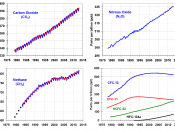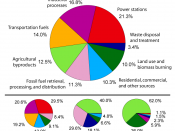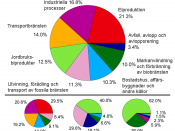Took a great deal of research and organization None
The relationship between humans and the state of the ecosystem is not only dependent upon how many people there are, but also upon what they do. When there were few people, the dominant factors controlling ecosystem state were the natural ones that have operated for millions of years. The human population has now grown so large that there are concerns that they have become a significant element in ecosystem dynamics. One of these concerns is the relationship between human activities and climate, particularly the recent observations and the predictions of global warming, beginning with the alarm sounded by W. Broecker (1975).
The relationships among humans, their activities and global temperature can be assessed by making the appropriate measurements and analyzing the data in a way that shows the connections and their magnitudes. Human population can be closely estimated and the consequences of their activities can be measured.
For example, the volume of carbon dioxide, methane and nitrous oxide emissions is an indicator of human's energy and resource consumption. An examination of population size, atmospheric concentrations of these gases and global temperature relative to time and with respect to each other is presented here to demonstrate the relations among these factors.
POPULATION GROWTH
Many of us have seen linear graphs of human population showing the enormous growth in the last two centuries. However, significant changes in population dynamics are lost in the exponential growth and long time scales. If the data are replotted on a log-population by log-time scale, significant population dynamics emerge. First, it is apparent that population growth has occurred in three surges and second, that the time between surges has dramatically shortened (Deevey, 1960).
Figure 1. Population (Log-population verses log-time since 1 million years ago). Time values on x-axis,



Paper update
There is a lot of good information in this paper. I like how the paper was writen and how the Reference page was updates after the paper was submitted. In my opinion this should have been an A+ paper. Good Job!
2 out of 2 people found this comment useful.